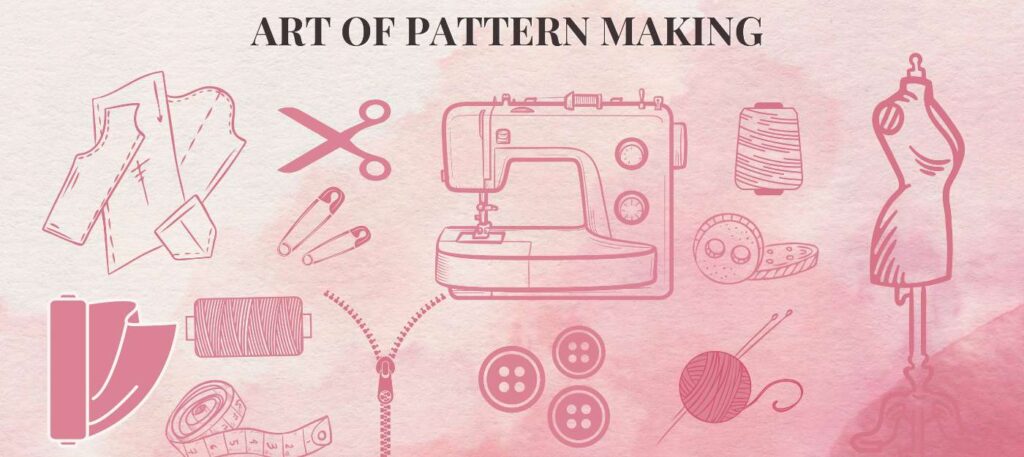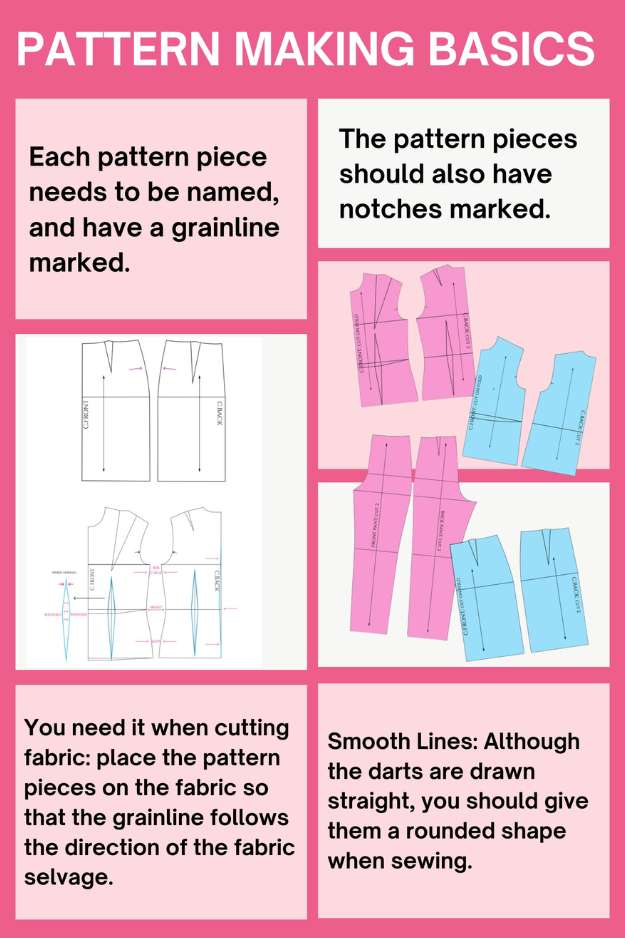FasDes- Best Fashion Designing and Modeling College in Jaipur

The Art of pattern making: “A Beginner’s Guide”
Pattern Making is an art that has been around for centuries. From traditional textile patterns to modern graphic design, Pattern Making is an important aspect of design that has always been prevalent in the world of art and design. Patterns can be found in almost every aspect of our daily lives, from our clothes to the wallpaper in our homes. In this blog post, we will explore the art of pattern-making, including what it is, the types of patterns, and how to create your own.
What is Pattern Making?
Pattern Making is the process of creating templates or guides that are used in the production of clothing, accessories, and other textile products. The pattern serves as a blueprint for the item being produced, indicating the shape and size of each piece of fabric and the placement of seams and other design elements.
Pattern-making involves a range of skills, including technical drawing, mathematics, and a thorough understanding of garment construction. Pattern-makers work closely with designers, translating their ideas into practical patterns that can be used by manufacturers to create the final product.
Pattern-making is essential in the fashion industry, as it allows for the efficient and accurate production of garments and ensures that the final product meets the designer’s specifications. It is also used in other industries, such as furniture manufacturing and automotive upholstery. Skilled pattern-makers are highly valued in these industries, as their expertise is essential to creating high-quality, well-fitted products.
The Importance of Pattern Making
Patterns are an important part of design because they can add visual interest and depth to an object or surface. They can be used to create a sense of rhythm, movement, and balance. Patterns can also be used to convey a message or tell a story, as is the case with many traditional textile patterns.
The process of pattern-making is essential for several reasons, including:
Accuracy: Pattern-making ensures that each garment is created with precision and accuracy, resulting in a perfect fit. This is crucial for the fashion industry, where small variations can make a significant difference in the final product’s quality.
Efficiency: Creating a pattern allows for the efficient use of fabric. By carefully planning and measuring the required fabric, waste can be minimized, saving money and reducing environmental impact.
Replicability: Once a pattern is created, it can be replicated repeatedly, resulting in a consistent product. This is important for large-scale production, where consistency and efficiency are key.
Creativity: Pattern-making can also be used to create unique and complex designs. By experimenting with different shapes and sizes, designers can create new and innovative garments.
Customization: Pattern-making allows for customization, where each garment can be tailored to fit an individual’s body shape and size. This is particularly important in the world of made-to-measure and bespoke fashion.
Want to learn Fashion Designing?
Join our Courses Now – Click Here


Methods of Pattern Making –
Drafting:
Drafting is a precise and systematic approach to pattern-making. It involves using measurements and calculations to create a pattern on paper or cardboard. This method allows for complete control over the garment’s shape, style, and fit. A basic understanding of garment construction and body measurements is essential for successful drafting. By manipulating the measurements and adding seam allowances, designers can create custom-fit patterns.
Draping:
Draping is an intuitive and hands-on method that involves directly manipulating fabric on a dress form or a live model. It allows designers to experiment with the fabric’s drape, texture, and movement, leading to unique and innovative designs. Draping encourages creativity and allows for spontaneous adjustments and refinements during the process. This method is particularly useful when designing garments with complex shapes, asymmetry, or fluidity.
Flat Paper Pattern Making:
Flat paper pattern making is a combination of drafting and draping techniques. It involves creating a pattern directly on paper, using a combination of measurements and basic shape templates. The resulting pattern is then transferred onto fabric and assembled into the final garment. This method is often preferred for its precision and efficiency, especially for simple or symmetrical designs. It provides a clear visual representation of the garment’s construction, making it easier to reproduce the pattern for multiple sizes or variations.
The Role of Pattern Makers in Fashion
Pattern makers play a crucial role in the world of fashion, acting as the bridge between a designer’s vision and the creation of a wearable garment. They are skilled professionals who transform design concepts into tangible patterns that serve as the blueprint for production.
One of the primary responsibilities of pattern makers is to ensure that the garments fit well on the human body. They meticulously analyze design sketches and translate them into precise measurements and markings on paper or computer software. Through their expertise in understanding the relationship between fabric, body shape, and construction techniques, pattern makers create patterns that optimize fit, comfort, and aesthetics.
Pattern makers also play a vital role in the production process. They collaborate closely with garment technicians, sample machinists, and production teams to ensure that the patterns are accurately translated into finished garments. They troubleshoot any issues that arise during the fitting and sampling stages, making necessary adjustments to achieve the desired fit and silhouette.
Additionally, pattern makers are instrumental in achieving consistency and standardization in sizing across a fashion brand. They develop graded patterns, which involve scaling the initial pattern up or down to accommodate various sizes. This ensures that the final garments maintain the design integrity and fit across different body types.
Why Patterns Are Essential in Clothing Manufacturing
Patterns are essential in clothing manufacturing for several reasons. Firstly, patterns serve as the foundation for garment production, providing the precise measurements and shapes necessary for cutting and sewing fabric pieces.
They ensure consistency and accuracy across different sizes and styles. Secondly, patterns allow for efficient material utilization, minimizing waste and optimizing production costs. Thirdly, patterns enable the replication of successful designs, facilitating mass production and ensuring consistent quality.
Finally, patterns serve as a reference for quality control, allowing manufacturers to compare finished garments with the original design to identify and correct any discrepancies. Overall, patterns streamline the manufacturing process, enhance efficiency, and uphold the desired aesthetics and fit of clothing items.

How to Create Your Own Patterns
Creating your own patterns can be a fun and rewarding process. There are many different techniques you can use to create patterns, including drawing, painting, printing, and weaving. To create your own patterns, follow these essential steps:
Step 1: Choose Your Materials
Choosing your materials is the first step in creating your own pattern. The materials you choose will depend on the technique you plan to use. For example, if you plan to draw your pattern, you will need paper and drawing utensils. If you plan to weave your pattern, you will need yarn and a loom.
Step 2: Choose Your Theme
The next step is to choose your theme. Your theme can be anything you want, from nature to geometric shapes to abstract designs. Think about what you want your pattern to communicate and choose a theme that aligns with that message.
Step 3: Sketch Your Design
Once you have chosen your theme, you can begin sketching your design. Start with a simple sketch and build on it as you go. Use your sketch as a guide and make adjustments as needed.
Step 4: Refine Your Design
Once you have a basic sketch of your design, you can begin refining it. Make sure the elements of your pattern are balanced and visually appealing. You may need to make several drafts before you achieve the desired result.
Step 5: Transfer Your Design
Once you have a final design, you can transfer it onto your chosen surface. If you are drawing or painting your pattern, you can transfer the design onto your paper or canvas using a pencil or transfer paper. If you are printing your pattern, you can transfer the design onto a printing plate or screen.
Step 6: Repeat your Design
The final step in creating your own pattern is to repeat your design. This is what makes a pattern a pattern – the repetition of the design over a surface or object. Depending on the technique you used to create your pattern, you may repeat it in different ways.
For example, if you draw your pattern on paper, you can repeat it by tracing or transferring the design onto multiple sheets of paper. If you painted your pattern on canvas, you can repeat it by painting the same design on multiple canvases. If you printed your pattern, you can repeat it by printing the same design on multiple surfaces.
When repeating your design, make sure to pay attention to the placement and orientation of the pattern. You want to create a seamless repeat, where the design flows smoothly across the surface without any interruptions or gaps.
To Learn Pattern Making – Click Here
Tips for Creating Successful Patterns
Creating successful patterns takes practice and experimentation. Here are some tips to keep in mind when creating your own patterns:
- Start with a simple design: When creating your first pattern, start with a simple design. This will help you get a feel for the process and allow you to build on your skills.
- Play with color: Color is an important aspect of pattern-making. Find out what color combination works best for your design by experimenting.
- Think about scale: The scale of your pattern can have a big impact on how it looks. Consider the size of the surface or object you are creating the pattern for and adjust the scale accordingly.
- Pay attention to balance: A balanced pattern is visually appealing and easy on the eyes. Make sure to distribute your design elements evenly across the surface.
- Don’t be afraid to experiment: The beauty of pattern-making is that there are endless possibilities. Don’t be afraid to experiment with different techniques and designs to see what works best for you.
Conclusion
Pattern-making is a versatile and exciting art form that has been around for centuries. Whether you are creating traditional textile patterns or modern graphic designs, patterns can add visual interest and depth to any object or surface. By following the steps outlined in this guide and experimenting with different techniques and designs, you can create your own unique patterns that reflect your personal style and creativity.
